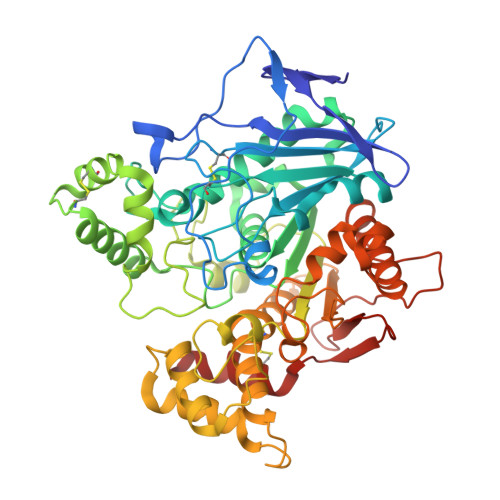The Magic of Crystal Structure-Based Inhibitor Optimization: Development of a Butyrylcholinesterase Inhibitor with Picomolar Affinity and in Vivo Activity.
Kosak, U., Brus, B., Knez, D., Zakelj, S., Trontelj, J., Pislar, A., Sink, R., Jukic, M., Zivin, M., Podkowa, A., Nachon, F., Brazzolotto, X., Stojan, J., Kos, J., Coquelle, N., Salat, K., Colletier, J.P., Gobec, S.(2018) J Med Chem 61: 119-139
- PubMed: 29227101
- DOI: https://doi.org/10.1021/acs.jmedchem.7b01086
- Primary Citation of Related Structures:
5NN0 - PubMed Abstract:
The enzymatic activity of butyrylcholinesterase (BChE) in the brain increases with the progression of Alzheimer's disease, thus classifying BChE as a promising drug target in advanced Alzheimer's disease. We used structure-based drug discovery approaches to develop potent, selective, and reversible human BChE inhibitors. The most potent, compound 3, had a picomolar inhibition constant versus BChE due to strong cation-¦Đ interactions, as revealed by the solved crystal structure of its complex with human BChE. Additionally, compound 3 inhibits BChE ex vivo and is noncytotoxic. In vitro pharmacokinetic experiments show that compound 3 is highly protein bound, highly permeable, and metabolically stable. Finally, compound 3 crosses the blood-brain barrier, and it improves memory, cognitive functions, and learning abilities of mice in a scopolamine model of dementia. Compound 3 is thus a promising advanced lead compound for the development of drugs for alleviating symptoms of cholinergic hypofunction in patients with advanced Alzheimer's disease.
Organizational Affiliation:
Faculty of Pharmacy, University of Ljubljana , A?ker?eva 7, 1000 Ljubljana, Slovenia.
























